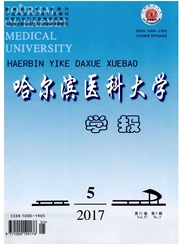

 中文摘要:
中文摘要:
目的初步探讨外源性精胺损伤心肌细胞的可能机制。方法培养乳鼠原代心肌细胞,随机分为正常对照组,精胺(Sp)损伤组和异搏定(VP)、超氧化物歧化酶(SOD)、三磷酸腺苷(ATP)、地塞米松(DEX)保护组;倒置显微镜观察心肌细胞形态学变化;生化法检测培养液中乳酸脱氢酶(LDH)活性;噻唑兰(MTT)法检测心肌细胞活力;电镜观察心肌细胞超微结构。结果100μmol/L Sp可造成培养大鼠乳鼠心肌细胞损伤,表现为LDH漏出增多,心肌细胞活力明显降低,心肌超微结构损伤严重。预先在培养液中加入一定浓度VP、SOD、ATP、DEX后,与Sp损伤组相比,培养液中LDH水平下降,心肌细胞存活率升高,心肌超微结构损伤减轻。结论外源性精胺可造成培养乳鼠原代心肌细胞损伤,其机制可能与细胞内钙超载、自由基增加、能量障碍、炎症介质释放有关。
 英文摘要:
英文摘要:
Objective To study the possible mechanisms of cardiomyocyte injury induced by exogenous spermine(Sp) .Methods Cardiomyocytes from 2 - 3 day-old rats were cultured in the RPMI-1640 medium. The morphological changes of cardiomyocytes were observed using microscope and transmission electron microscope. The cardiomyocyte viability was detected by MTT assay,and the lactate dehydrogenase (LDH) activity in the medium was measured.Results Sp(100μmol/L) induced the injury of cultured neonate rats cardiomyocytes. The LDH leakage increased, the cardiomyocyte viability decreased significantly, and the ultrastructure of cardiomyocytes was injuried severely in the spermine-treated group. After pretreatment with VP, SOD, ATP and DEX in certain concentration, the LDH activity was decreased, and the cardiomyocyte viability was higher, and the ultrastructural injuries were improved compared with Sp-treated group. Conclusion Exogenous spennine could induce the injury of cultured neonatal rat cardiomyocytes, and its mechanisms may relate to intracellular calcitun overload, free radical increase, energy disorder, and inflammatory mediators release.
 同期刊论文项目
同期刊论文项目
 同项目期刊论文
同项目期刊论文
 期刊信息
期刊信息
